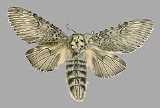
Cerura vinula
Encyclopedia
The Puss Moth is a lepidoptera
n from the family Notodontidae
.
The moth can be found in Europe
and North Africa
. It has a wingspan of 58 to 75 mm. The moth survives the winter as a Pupa
in a very solid, wood reinforced cocoon, attached to a tree or pole.
The host plants of the moth are the willow
and the poplar
, especially the aspen
. When disturbed, the caterpillars strike a defensive pose and might squirt formic acid at the attacker if the defense warning is unheeded.
This moth is mostly discovered in very dense and woodland areas.
Lepidoptera
Lepidoptera is a large order of insects that includes moths and butterflies . It is one of the most widespread and widely recognizable insect orders in the world, encompassing moths and the three superfamilies of butterflies, skipper butterflies, and moth-butterflies...
n from the family Notodontidae
Notodontidae
Notodontidae is a family of moths with approximately 3,500 known species. Moths of this family are found in all parts of the world, but they are most concentrated in tropical areas, especially in the New World...
.
The moth can be found in Europe
Europe
Europe is, by convention, one of the world's seven continents. Comprising the westernmost peninsula of Eurasia, Europe is generally 'divided' from Asia to its east by the watershed divides of the Ural and Caucasus Mountains, the Ural River, the Caspian and Black Seas, and the waterways connecting...
and North Africa
North Africa
North Africa or Northern Africa is the northernmost region of the African continent, linked by the Sahara to Sub-Saharan Africa. Geopolitically, the United Nations definition of Northern Africa includes eight countries or territories; Algeria, Egypt, Libya, Morocco, South Sudan, Sudan, Tunisia, and...
. It has a wingspan of 58 to 75 mm. The moth survives the winter as a Pupa
Pupa
A pupa is the life stage of some insects undergoing transformation. The pupal stage is found only in holometabolous insects, those that undergo a complete metamorphosis, going through four life stages; embryo, larva, pupa and imago...
in a very solid, wood reinforced cocoon, attached to a tree or pole.
The host plants of the moth are the willow
Willow
Willows, sallows, and osiers form the genus Salix, around 400 species of deciduous trees and shrubs, found primarily on moist soils in cold and temperate regions of the Northern Hemisphere...
and the poplar
Poplar
Populus is a genus of 25–35 species of deciduous flowering plants in the family Salicaceae, native to most of the Northern Hemisphere. English names variously applied to different species include poplar , aspen, and cottonwood....
, especially the aspen
Aspen
Populus section Populus, of the Populus genus, includes the aspen trees and the white poplar Populus alba. The five typical aspens are all native to cold regions with cool summers, in the north of the Northern Hemisphere, extending south at high altitudes in the mountains. The White Poplar, by...
. When disturbed, the caterpillars strike a defensive pose and might squirt formic acid at the attacker if the defense warning is unheeded.
This moth is mostly discovered in very dense and woodland areas.

